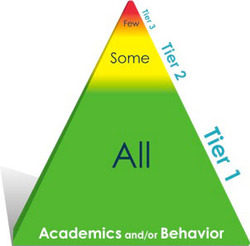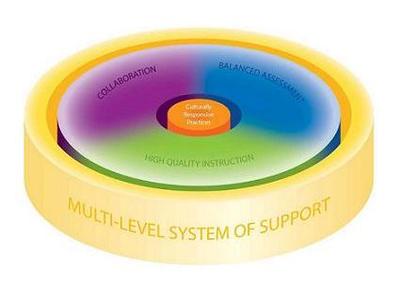- Almond-Bancroft School District
- District RTI
-
What Is RTI?
RTI (Response to Intervention) is a school-wide system for all students that involves academics and behavior. The main goal of RTI is to identify students who may need additional support as soon as possible and provide that support. RTI is used with students who are struggling but can also be used for students who are high achievers and may need supplemental instruction. It is about providing students with what they need when they need it.
RTI is often described in 'Tiers'

*The following explanation of Tiers refers to the academic part of RTI. For more information on the behavioral component, please visit our District PBIS page.
Tier 1: Universal instruction in the general education classroom and includes approximately 80% of the student population. The main focus in Tier 1 is on universal curriculum and differentiating instruction for students who may need extra assistance. All students grades K-8 are assessed three times a year (fall, winter, spring) in the areas of reading and math using the district benchmarking system (AIMSweb). The district uses this information along with classroom data to determine which students may need extra assistance. Students grades 9-12 are assessed at various points throughout the year using assessments such as WKCE (Elementary and Middle School also), PLAN, EXPLORE, ASVAB, PSAT, and the Accuplacer. For more information on what these assessments cover and when they are administered, please contact the High School Guidance Counselor. Students not making appropriate progress in Tier 1 will be considered for Tier 2 intervention.
Tier 2: This tier includes approximately 10-15% of the student population. Students in grades K-5 receive small group interventions, in addition to the general education curriculum. These interventions are delivered by the classroom teacher, or other professionals in the general education setting. Some students in Tier 2 may receive interventions with the Title 1 teacher. Students who are in Tier 2 may be progress monitored once a month or a couple times a month. Progress monitoring involves giving the students quick (1 to 3 minute) 'probes' in reading and/or math. Their scores on these probes are downloaded into the AIMSweb program and the teachers can print out charts that show the students progress in response to the interventions. Students in grades 6-12 receive additional support during ELT (extended learning time) time that is built into their schedules. Students in grades 6-12 may also be considered for the At-Risk program. At this time students in grades 6-8 are also progress monitored using AIMSweb and students in grades 9-12 are monitored based on classroom assessments. Students not making appropriate progress in Tier 2 will be considered for Tier 3 intervention.
Tier 3: This tier includes approximately 1-5% of the student population. Students in grades K-5 in this tier will be receiving intensive interventions in very small groups or one-on-one. These interventions may be delivered in the general education classroom or in a different classroom depending on the individual student's needs. These students will also be progress monitored, however, it can occur one to two times a week. Students in grades 6-12 may be in the At-Risk program and may need more one-on-one support in addition to the ELT (extended learning time) time built into their schedules. Students who are in Tier 3 and not making appropriate progress may be referred for a special education evaluation. *It should be noted that a special education referral can occur at any tier level, however if not enough data has been collected, the evaluation process may be delayed.
-
RTI Resources/Links
Wisconsin's vision for RTI http://rti.dpi.wi.gov/ *The Wisconsin model does not use the 'triangle' graphic, however the concepts are the same. The state has given districts the flexibility of designing their own RTI model. The Almond-Bancroft District follows the same principles that are in the WI graphic, although we chose to use the triangle representation.
Wisconsin RTI Graphic


